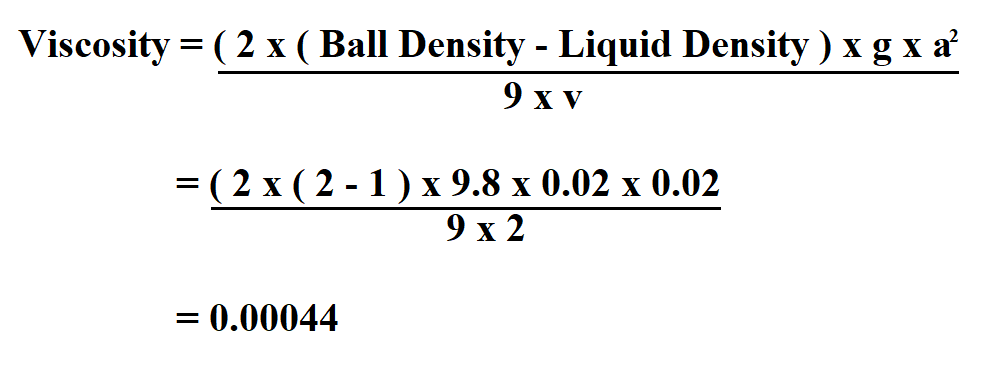


Furthermore, the second law of thermodynamics states that all fluids must have positive viscosity, and fluid with zero viscosity is referred to as ideal or inviscid. However, in some situations, the dependency on these parameters is minor, and in superfluids, zero viscosity is only found at very low temperatures. The temperature, pressure, and rate of deformation of fluid can all affect its state. The viscosity of a fluid is determined by its condition. Experiments reveal that some stress is required to maintain the flow, which is due to the necessity for a force to overcome the friction between the fluid layers in relative motion. When a viscous fluid is driven into a tube, it flows more swiftly near the tube’s axis than at its walls, and viscosity measures the internal frictional force between adjacent layers of fluid in relative motion. Uric Acid: Normal Range, Medicine, Control, TreatmentĪ fluid’s viscosity is a measure of its resistance to deformation at a certain rate, and it correlates to the colloquial concept of “thickness” in liquids.A fluid with low viscosity, on the other hand, flows smoothly because its molecular nature causes very little friction when moving. Because of its strong intermolecular tensions, it has a lot of internal friction, which prevents layers from moving past one another. When fluid has a high viscosity, it inhibits movement. It is caused by internal friction between the fluid layers as they slip past one another while fluid moves. Viscosity is a measure of a fluid’s thickness or resistance to items passing through it. Most fluids have some resistance to motion, which we call viscosity, which occurs when the fluid’s layers move relative to one another. Is it true that water has a high viscosity?.What is the best way to break viscosity?.What are the different kinds of viscosity?.What causes viscosity in the first place?.FAQs on Viscosity of Water: Meaning, Formula, Unit, Examples, Symbol.NCERT Solutions For Statistics Class 11.A copy of the complete standard may be purchased from ASTM International, astm. For user reference, 1 mm2/s = 10-6m 2/s = 1 cSt.Įxtracted, with permission, from ASTM D2270-10 - Calculating Viscosity Index from Kinematic Viscosity at 40 ☌ and 100 ☌, copyright ASTM International, 100 Barr Harbor Drive, West Conshohocken, PA 19428. No other units of measurement are included in this standard.ġ.4.1 The values stated in SI units are to be regarded as the standard.
#Kinematic viscosity formula iso#
The determination of the kinematic viscosity of a petroleum product shall be carried out in accordance with Test Methods D445, D7042, IP 71, or ISO 3104.ġ.3.1 If Viscosity Index calculated for a given sample using kinematic viscosity measurements from different test methods are in disagreement, the values calculated from Test Method D445 measurements shall be accepted.ġ.4 The values stated in SI units are to be regarded as standard. See Test Method D341, Annex A1.ġ.3 The kinematic viscosity values are determined with reference to a value of 1.0034 mm2/s at 20.00 ☌ for distilled water. Such viscosity index data may be considered as suitable for information only and not for specification purposes. Equations are provided for calculating viscosity index for petroleum products having kinematic viscosities above 70 mm2/s at 100 ☌.ġ.2.1 In cases where kinematic viscosity data are not available at temperatures of 40 ☌ and 100 ☌, an estimate may be made of the viscosity index by calculating the kinematic viscosity at temperatures of 40 ☌ and 100 ☌ from data obtained at other temperatures. Table 1 given in this practice applies to petroleum products with kinematic viscosities between 2 mm2/s and 70 mm2/s at 100 ☌. NOTE 1: The results obtained from the calculation of VI from kinematic viscosities determined at 40 ☌ and 100 ☌ are virtually the same as those obtained from the former VI system using kinematic viscosities determined at 37.78 ☌ and 98.89 ☌.ġ.2 This practice does not apply to petroleum products with kinematic viscosities less than 2.0 mm2/s at 100 ☌. 4.1 The viscosity index is a widely used and accepted measure of the variation in kinematic viscosity due to changes in the temperature of a petroleum product between 40 ☌ and 100 ☌.Ĥ.2 A higher viscosity index indicates a smaller decrease in kinematic viscosity with increasing temperature of the lubricant.Ĥ.3 The viscosity index is used in practice as a single number indicating temperature dependence of kinematic viscosity.Ĥ.4 Viscosity Index is sometimes used to characterize base oils for purposes of establishing engine testing requirements for engine oil performance categories.6ġ.1 This practice2 covers the procedures for calculating the viscosity index of petroleum products, such as lubricating oils, and related materials from their kinematic viscosities at 40 ☌ and 100 ☌.


 0 kommentar(er)
0 kommentar(er)
